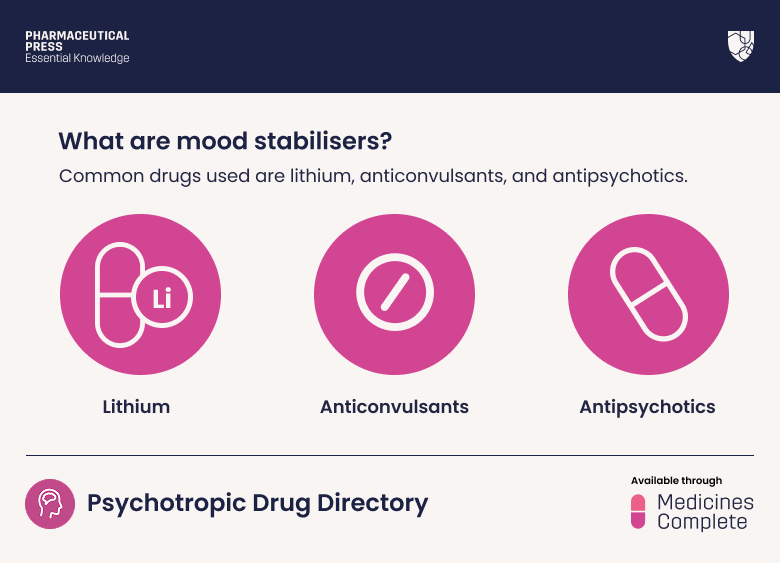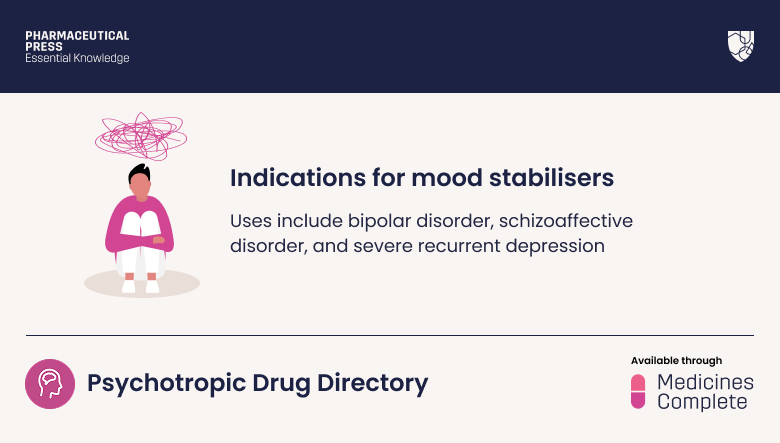Mood stabilisers for bipolar disorder
In this article, we will explain when mood stabilisers are needed, how they work, and the different types. We will also outline factors that guide treatment choices.
Please complete the form at the bottom of this article to request a complimentary trial of MedicinesComplete.
When are mood stabilisers needed?
Mood stabilisers are used in the treatment of mood disorders including bipolar disorder, schizoaffective disorder, and recurrent severe depression.¹ ²
Bipolar disorder (previously known as manic depression) is a serious, long-term condition that affects one in every 50 adults at some point in their life.³ It is characterised by recurrent episodes of depression, hypomania or mania. Mania and hypomania are periods of elevated, expansive, or irritable mood, with increased energy or activity that impact on the ability to function normally. The two extremes of mania and depression tend to occur at different times, though people may also experience a “mixed state” with symptoms of both at the same time.⁴ ⁵
Bipolar disorder can have a profound impact on someone’s relationships, their ability to go about their everyday life, and, on their quality of life. The consequences of not managing the highs and lows of bipolar disorder can be devastating: between 14-59% of people with bipolar disorder experience suicidal ideation and between 25-56% of people with bipolar disorder attempt suicide at least once in their lifetime.⁵
Other harms linked to acute episodes include financial difficulties from over-spending, alcohol and substance misuse, traumatic injuries, and accidents.⁴ ⁵
Schizoaffective disorder combines features of both mood disorders (depression or mania) and schizophrenia symptoms.
Recurrent severe depression is characterised by repeated episodes of depression that can be difficult to treat.
Download our Psychotropic Drug Directory user guide. Psychotropic Drug Directory supports the optimal and rational use of mental health medications, to improve the quality of life for people with mental health needs.
What are mood stabilisers?

Mood stabilisers are drugs used to treat mood disorders, they help to even out mood swings, and prevent manic or depressive episodes from occurring,² ⁵ ⁶ which may reduce the need for hospitalisation or other interventions. Mood stabilisers include lithium, anticonvulsants and antipsychotics.²
How do mood stabilisers work?
Mood stabilisers work differently depending on the class of drug. Although they have been used for decades, their mechanisms of action in mood disorders are not fully understood.⁶ ⁷ Their actions include modulation of different neurotransmitters in the brain, such as glutamate, serotonin and dopamine.
Management and treatment choices
The management of bipolar and other mood disorders can be complex. In bipolar disorder, for example, the type of mood episode (depressed, manic or hypomanic) and the presence of mixed features, rapid cycling, or psychotic symptoms guides management.³ ⁴ ⁵ Treatment-refractory bipolar disorder can be particularly challenging to address.
Choice of therapy also depends on the individual patient, considering the type and severity of symptoms, treatment history, comorbidities, any previous drug side effects and patient preferences.⁵ Drugs which are well tolerated by the patient should be used, as adverse effects of medicines contribute to the increased mortality seen in this patient cohort, and limit concordance with therapy.
Lithium retains an important role in the long-term treatment of bipolar disorder, with anti-manic, antidepressant and anti-suicidal effects. However, lithium is high risk in overdose and is associated with side effects, including tremor, polyuria, weight gain, renal toxicity and hypothyroidism. Regular blood tests to monitor lithium levels, renal and thyroid function are needed throughout treatment with lithium.² ³ ⁴
Antipsychotics prescribed for their mood stabilising properties include aripiprazole, olanzapine, quetiapine, risperidone, haloperidol and asenapine. They can be associated with metabolic side effects, including dyslipidaemia and hyperglycaemia, and movement disorders.¹
Anticonvulsants that can be used as mood stabilisers are carbamazepine, lamotrigine and valproate. These medications can cause fatigue, weight gain, nausea, and headache. Side effects include blood disorders, liver dysfunction, rare skin rashes and vision problems. Valproate is a potent teratogen, and its use is now tightly regulated.⁶
By reducing mood fluctuations and preventing relapse, mood stabilisers play a vital role in managing bipolar disorder and other mood disorders.
Trial form
Please complete the form below to request a complimentary trial to knowledge products through MedicinesComplete.
References
- Rybakowski, J. K. (2023). Mood stabilizers of first and second generation. Brain Sciences, 13(5), 741.
- Mind. (2020). Lithium and other mood stabilisers. Available at: https://www.mind.org.uk/information-support/drugs-and-treatments/lithium-and-other-mood-stabilisers/about-mood-stabilisers/ Last accessed: 26 June 2025.
- Royal College of Psychiatrists. (2020). Bipolar disorder. Available at: https://www.rcpsych.ac.uk/mental-health/mental-illnesses-and-mental-health-problems/bipolar-disorder Last accessed: 26 June 2025.
- BMJ Best Practice. Bipolar Disorders. BMJ Publishing Group Ltd Last updated Sept 27 2024. Last accessed: 8 July 2025.
- NICE. (2025). Clinical Knowledge Summaries: Bipolar disorder. Available at: https://cks.nice.org.uk/topics/bipolar-disorder/ Last accessed: 26 June 2025.
- CAMH. (n.d.). Mood Stabilizing Medication. Available at: https://www.camh.ca/en/health-info/mental-illness-and-addiction-index/mood-stabilizing-medication Last accessed: 26 June 2025.
- Nath, M., & Gupta, V. (2020). Mood stabilizers. Treasure Island (FL). StatPearls Publishing; [Internet].









